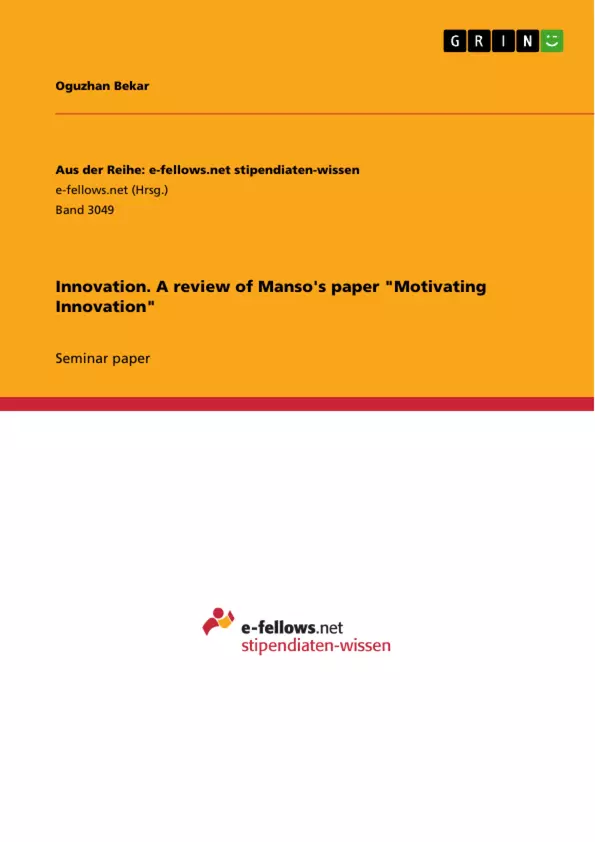This paper is a review of Manso's paper "Motivating Innovation" and is structured as follows: After summing up the theoretical and empirical results, the ambigious effects of Job Security will be critically discussed. Afterward it will be commented on some assumptions made in this paper while suggesting further novel research. Finally, the main findings of Manso will be stated.
In the age of disruptive technologies and business models, the most crucial factor innovation is moving more and more into the focus of attention of society. As leading innovative countries set the baron efficient solutions higher, the determinants stay somewhat nebulous. While Zahra and Covin (1994) suggest that "Innovation is widely considered as the [lifeblood] of corporate survival and growth", Bessant et al (2005) emphasize a more general defnition: "Innovation represents the core renewal process in any organization." The latter statement suggests that innovation is not solely important for business organizations but rather for any kind of complex institutions. While the USA emphasized the significance of innovation by launching the Department of Innovation alreadyin 2008 , Germany has increased the public funding of Research and Development by 0.5 percentage points to 3.5percent in the new coalition agreement in 2018. The Department of Trade of the UK exemplifes the relevance of accumulated innovation within acountry.
Many scientists have researched on the subject innovation. So do Aghion and Tirole (1994) argue that the outcomes of innovation are unclear, ergo it is difficult to find a cohesive contract which motivates innovation. Whereas the latter paper is studying the measurability of innovation, Manso’s article looks closely at the process of innovation and focuses on the central trade-off between exploration and exploitation. Moreover, Weitzman (1979) uses a simple bandit-problem to describe the innovation process. The substantial difference to Motivating Innovation is that Manso does not only study individual decision problems but also complements the agent by the principal to embed the bandit-problem into a principal-agentframework.The Principal-Agent setting allows him to inquire the tension between exploration and exploitation under a more realistic contract in which the agent usually exhibits private costs when receiving tasks from the principal.
Inhaltsverzeichnis (Table of Contents)
- Introduction
- Methodology
- Theoretical Approach
- Exploration and Exploitation
- The Principal-Agent Problem
- Incentives for Exploration and Exploitation
- Role of Commitment
- Optimal termination policy of the principal for exploration
- Provision of feedback
- Reference to Empirical Implications and Approaches
- Empirical Implications
- Empirical Approaches
- Theoretical Approach
- Critics and Further novel research
- Conclusion
- Appendix
- Propositions
- Figures
Zielsetzung und Themenschwerpunkte (Objectives and Key Themes)
This seminar paper reviews Gustavo Manso’s article “Motivating Innovation”, focusing on the central trade-off between exploration and exploitation in the context of innovation. It examines the principal-agent framework and explores how to design contracts that motivate agents to engage in both exploration (innovation) and exploitation (conventional work methods). The paper delves into the empirical implications of the theoretical model, particularly the role of reward for early failure and continuation policies in encouraging exploration.
- The tension between exploration and exploitation in innovation
- The principal-agent problem in the context of innovation
- Designing contracts to motivate exploration and exploitation
- Empirical implications of theoretical models on innovation
- The role of reward for early failure and continuation policies
Zusammenfassung der Kapitel (Chapter Summaries)
- Introduction: This section introduces the concept of innovation in the context of disruptive technologies and business models. It highlights the importance of innovation for organizational survival and growth, citing various research findings and examples from different countries. It then introduces Manso’s article “Motivating Innovation” and its focus on the trade-off between exploration and exploitation.
- Methodology: This section outlines the theoretical and empirical approaches used in the paper. It provides a detailed overview of Manso’s theoretical framework, which uses a two-armed bandit problem to model the decision-making process between exploration and exploitation. It further elaborates on the principal-agent setting and the role of contract design in motivating agents to engage in innovation.
- Critics and Further Novel Research: This section critically examines the implications of job security and other assumptions made in the paper. It proposes areas for future research, highlighting the need for further investigation into the incentives for exploration and exploitation in different organizational contexts.
Schlüsselwörter (Keywords)
The key terms and concepts explored in this seminar paper include innovation, exploration, exploitation, principal-agent problem, contract design, reward for early failure, continuation policies, empirical implications, job security, and organizational contexts. The paper utilizes the theoretical framework of the two-armed bandit problem and examines the practical implications of these concepts for motivating innovation within organizations.
- Quote paper
- Oguzhan Bekar (Author), 2018, Innovation. A review of Manso's paper "Motivating Innovation", Munich, GRIN Verlag, https://www.grin.com/document/459582



